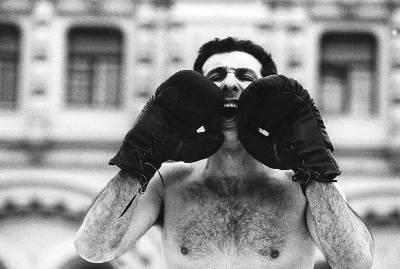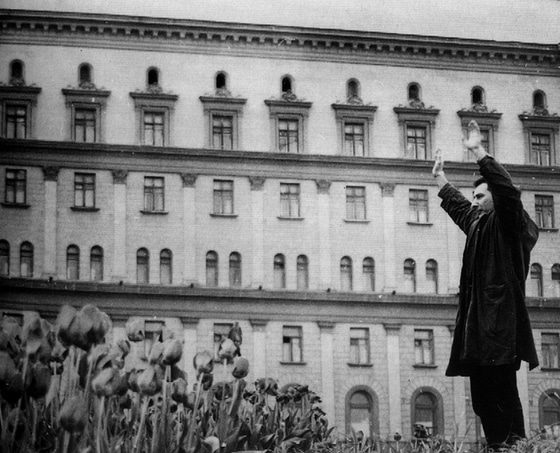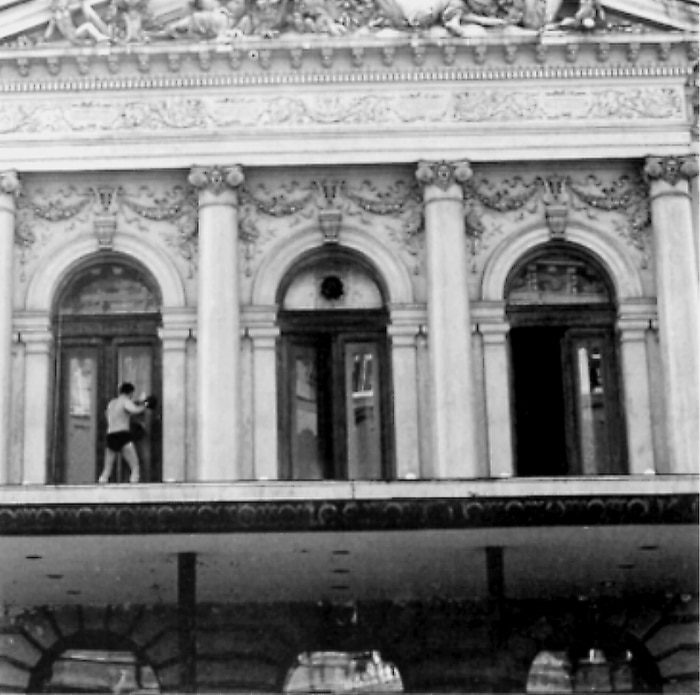1. I contend that the epoch of optical, armed vision in art is drawing to a close. Opened by the Impressionists, its end has come with pitiful computer art. This epoch is being replaced by an epoch of new sensuality, an epoch of tangible relationships with the world.
2. We have not yet liberated ourselves from the power of the departing epoch; in many respects, we are still the obedient heirs to this moribund age. In particular, the sense of personality, as defined at the beginning of the century, is still prevalent to a considerable degree. Its main feature is that it resolutely transfers the center of gravity from the outside in. This leads to the blossoming of what is called intellectual reflection, which triumphs in art and results in some kind of major dissonance, throwing open a gap between our “selves” and our behavior in the world, a gap that we knowingly accept and justify. This gap can be described by a very simple and self-evident formula: modern man does not have the courage to be what he perceives himself to be and does not want to perceive himself as what he really is. Instead, he prefers to produce optical illusions, to develop an enormous mass of new means that allow him to follow the fundamental law of reflexive self-consciousness, the law of inner excuses. In other words, man no longer lives in the world and no longer judges the world; he only entertains himself by watching the world’s capricious reflections in his own image. Having accepted the “deaths” of “God”, “man”, and “art”, contemporary self-consciousness dooms itself to continue explaining and justifying all these “deaths”- in accordance with the laws by which it is governed -, accepting a responsibility for them that is just as illusory as all of these “deaths” themselves.
3. The horizon of contemporary optical vision is closed and limited: it embraces no more than an insignificant part of the subject’s integrated psychophysical existence and a tiny part of the world’s being. First and foremost, self-consciousness does not know the body: it is only aware of the vague and confusing, often deceitful reflections of corporeal life, which it recognizes with the help of movie-, video- and photo-images. These methods of broadcasting corporeal life do not provide a complete picture of corporeal existence; they are as illusionary as ballet, for an example, no more than vague shadows of the previous century’s military parades, no more than anatomic atlases for art students, atlases of the dead body. Consciousness is so frightened of the body that it steps into an eternal struggle with its corporeality, only tolerating it as a set of separate “body”-symbols. Cindy Sherman fixes these discrete symbols in her photo-series, which are little more than a simulation of the body’s “cultural” or “historical” existence. Sherman’s works do not refer the audience to the body itself, nor do they refer to its life, but to other photos, movies and paintings. On the other hand, Bruce Nauman’s video-works interpret the body as the object of total violence caused by the world and other bodies. For Nauman, the body is the last, final distinction; thus, it is pure fatality, destruction and abuse. The body is not only abused by the law of tragedy, but also by the law of farce.
4. However, consciousness is not only just unaware of the body. It does not know the world either. Since consciousness that has become an end in itself, self-perception separated from self-implementation can only see the world optically or falsely, in other words.
I contend that modern vision arises from cowardly self-indulgence and impotent greed. It feeds and lives on these feelings. In fact, consciousness only germinates in action; the internal only realizes itself in the exterior world through choice. To “choose” in the direct meaning of the word means to approve of one opportunity, courageously rejecting an infinite number of other potential choices. Thus, more than anything else, choice entails a readiness to repudiate and renounce. Without this readiness, consciousness is self-indulgent; it greedily clings to all of its opportunities and wants to sacrifice nothing of its ghostly wealth, thus retaining only one chance, namely to avoid any realization at all. That is how modern vision behaves: it devotes itself to admiring opportunities for their own sake. Television is the reflection of such an attitude towards the world. Rather than inducing active social, existential or ethical action, television submerges the mass audience into a strange ethical stupor and a monstrous form of existential cynicism. Watching in military operations somewhere in former Yugoslavia and a Paris fashion show in the same short period of time is not only an informative sensation, but also personifies human impotence in its final form.

5. Contemporary vision – and this is something anyone can experience on their own – takes form through images of that which is unrealizable or that which has not been realized, of what we cannot, do not dare, or do not want to do, but what we still do not risk rejecting totally, imperiously it pushing out to oblivion. On the contrary, we thoroughly cultivate these images, regardless of their content: documentary footage of the Kennedy assassination, Marilynn’s photographed charms, Warhol’s silk-screen reproductions, Hollywood plots… Turning away from the world and ourselves, we greedily peer into the tenuous flow of such images and search them in hope of finding ourselves. Sinking in this flickering fog, we begin to believe that we are submerging into ourselves, into the depths of our innermost essence…
6. It is remarkable, however, that in the moments of the utmost exertion, when a human is most of all himself, he thinks of himself least of all: his gaze is not directed inward at the self, but outward, at the world, at the object of his action. He is totally involved in his act. This often happens in moments of severe danger or immense physical tension, in moments of erotic absorption or ethical effort. At such times, measured in minutes, the internal is identified with the external; the feeling of integrity and completeness suffuses the act itself, indivisibly accompanying its rhythm. Everyone has experienced this in one way or another and can remember that the real feeling of personality does not at all resemble self-immersion or intellectual reflection. Quite on the contrary: in order to engage in self-reflection, you have to be feeble and weak; you have to stop being yourself. Thus, reflexive consciousness does not result in the integration of the observer’s integrated “self” nor does it bring together the world in its entirety, but produces psychological odds-and-ends, atoms of psychophysical being, this or that discourse of projections. This, in fact, is how optical vision realizes itself, eliminating both the self and the world through self-analysis armed to the teeth with technical innovations. This vision unfolds completely in illusionist consciousness, which is directed towards psychologism and discursiveness, and not towards self-fulfillment and existence.

7. What can be opposed to optical vision in the framework of the theories and practices of art today? Only one thing, namely art that aims at reworking human relationships alteration. I contend that only the modification of human relationships and the fundamental redevelopment of the entire emotional, psychical and conscious sphere of humanity could be the objective for an artist today. A new sensuality, based on total openness and self-realization, will determine the future of art. It is nearly impossible to alter human relationships in a world determined by universal survival on the one hand and technological illusionism on the other, especially since we’re not talking about yet another utopia. Instead, I mean that an artist should strive to offer integrated confessions of faith, stepping into a comprehensive dialogue with the world, in a maximum of tension and response, at the breaking point between laughter and terror. The artist should finally be able say what he thinks. In order to do so, he has to start thinking at the very least.
By the way, it seems obvious that there is, in fact, one sphere where human thought is alive and kicking, and this, no doubt, is the sphere of disgrace: once again, humanity is being deceived by the powers that be, and yet again, it needs to become indignant and to act, bearing the burden of hatred and love in order to do so. It may be hard, thankless and nearly ridiculous to remind people of love and hate. But nothing but the scandalous awakening of these feelings will be able to raise art to its feet after it has been thus worn out and depreciated. The only artistic movement capable of saying anything new is a movement in which all means of representation are the results of basic human feelings, aimed at turning humanity toward integrated action in that difficult border-zone where aesthetics joins ethics and poetics joins politics. And it is seem completely self-evident and necessary to realize that this breakthrough will be directed at political action as one of the ultimate modes of human expression.
8. No ethical or aesthetic prejudice will ever be able to stop the artist as long as he dares to follow the path of complete openness. In a sphere where a regime of playful, arrogant-abstract, optical-technological survival has established itself so recently, this openness can only bear a personal and private character. ✪
![[Futuristika!]](https://futuristika.org/wp-content/uploads/2020/12/futuristika-logo.png)

